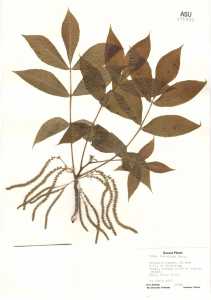Trees, rarely shrubs , 3-52 m. Bark gray or brownish, smooth with fissures in younger trees, becoming ridged and sometimes deeply furrowed or exfoliating with small platelike scales or long strips or broad plates. Twigs greenish, orangish, reddish, or rusty brown, or bronze, terete, slender or stout, pubescent and scaly or glabrous; leaf scars shield-shaped or 3-lobed, large; pith solid and homogeneous. Bud scales valvate or imbricate, glabrous or variously pubescent; axillary buds protected by pair of valvate bracteoles (i.e., prophylls) or bracteoles fused into hood. Leaves odd-pinnate; petiole pubescent and/or scaly or glabrous. Leaflets 3-17(-21), petiolulate, distal leaflets largest, 2-26 × 1-14 cm; surfaces abaxially with nonglandular hairs (unicellular common to all species, fasciculate with 2-8 rays in 1 rank, multiradiate with 8-17 rays in 2 ranks) and glandular scales (capitate-glandular and large peltate scales common to all species; small peltate scales round, irregular, or 2- or 4-lobed), adaxially with scattered hairs and scattered to abundant scales in spring or concentrated along midrib and secondary veins to essentially glabrous in the fall. Staminate catkins in fascicles of 3 (except sect. Rhamphocarya of se Asia) from 1st-, sometimes 2d-year twigs, sessile or pedunculate; stamens 3-10(-15) per flower, with or without hairs. Pistillate flowers in terminal few-flowered spikes. Fruits nuts enclosed in husks, compressed or not compressed, husks completely or partially dehiscing, sutures smooth or winged; nuts brown, reddish brown, or tan, sometimes mottled with black or tan, compressed or not compressed, angled or not angled, smooth, rugulose, or verrucose; shells thin or thick. Seeds sweet or bitter. x = 16.
Carya was widespread during the Tertiary; fossils have been reported from the states of Colorado and Washington, and from China, Japan, Europe, and western Siberia. Today two sections of the genus occur in southeastern Asia (sect. Rhamphocarya and sect. Sinocarya ) and two in North America (sect. Apocarya , the so-called pecan hickories, and sect. Carya , the true hickories). Both 2 n = 32 and 2 n = 64 chromosome numbers are known for the genus; tetraploidy, however, is confined to sect. Carya .
The commercial use of Carya is substantial. The cultivated pecan, C . illinoinensis , is the most important nut tree native to North America, and the wood of the true hickories is unequaled for its use in tool handles because of the combined strength and shock resistance. Hickory nuts are also an important, high-quality food source for wildlife because they are high in proteins and fats. Carya cordiformis , C . glabra , and C . ovata are grown extensively in central Europe for timber.
Characters of the buds and bark are taxonomically important in Carya , but shoots with terminal buds and information about bark characteristics are frequently absent on herbarium specimens. Phenotypic variation from tree to tree is often considerable and difficult to quantify. Most of this variation undoubtedly results from adaptation to local and regional conditions; hybridization has probably played a subtle role as well. Sympatry of two or more species is common, and artificial pollinations suggest that even diploid × tetraploid crosses produce viable seed.
Staminate catkins slender, elongate, borne in peduncled groups of 3 at the summit of the previous year's growth or at the base of that of the current year; "perianth" 2-3-lobed, closely subtended and usually surpassed by the bract; stamens 3-10, commonly 4; anthers pilose; pistillate fls solitary or in spikes of 2-10, terminating the branches, each closely subtended by a cup-shaped, 4-lobed, perianth-like involucre that ripens with the fr to form a husk; tepals obsolete, husk ±dehiscent into 4 valves, releasing the hard shelled nut; trees with hard, heavy wood, continuous pith, and odd-pinnate lvs, the 3 terminal lfls usually the largest; lfls with involute vernation. (Hicoria) 15, e. N. Amer. and e. Asia.
Gleason, Henry A. & Cronquist, Arthur J. 1991. Manual of vascular plants of northeastern United States and adjacent Canada. lxxv + 910 pp.
©The New York Botanical Garden. All rights reserved. Used by permission.












